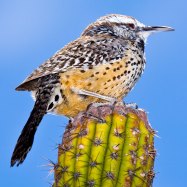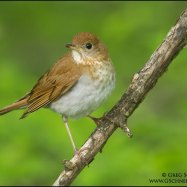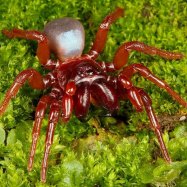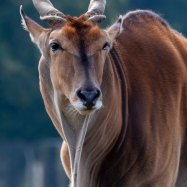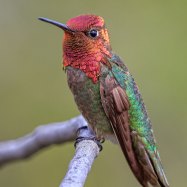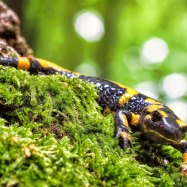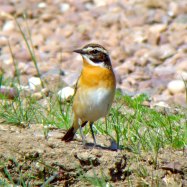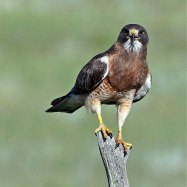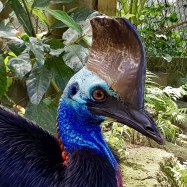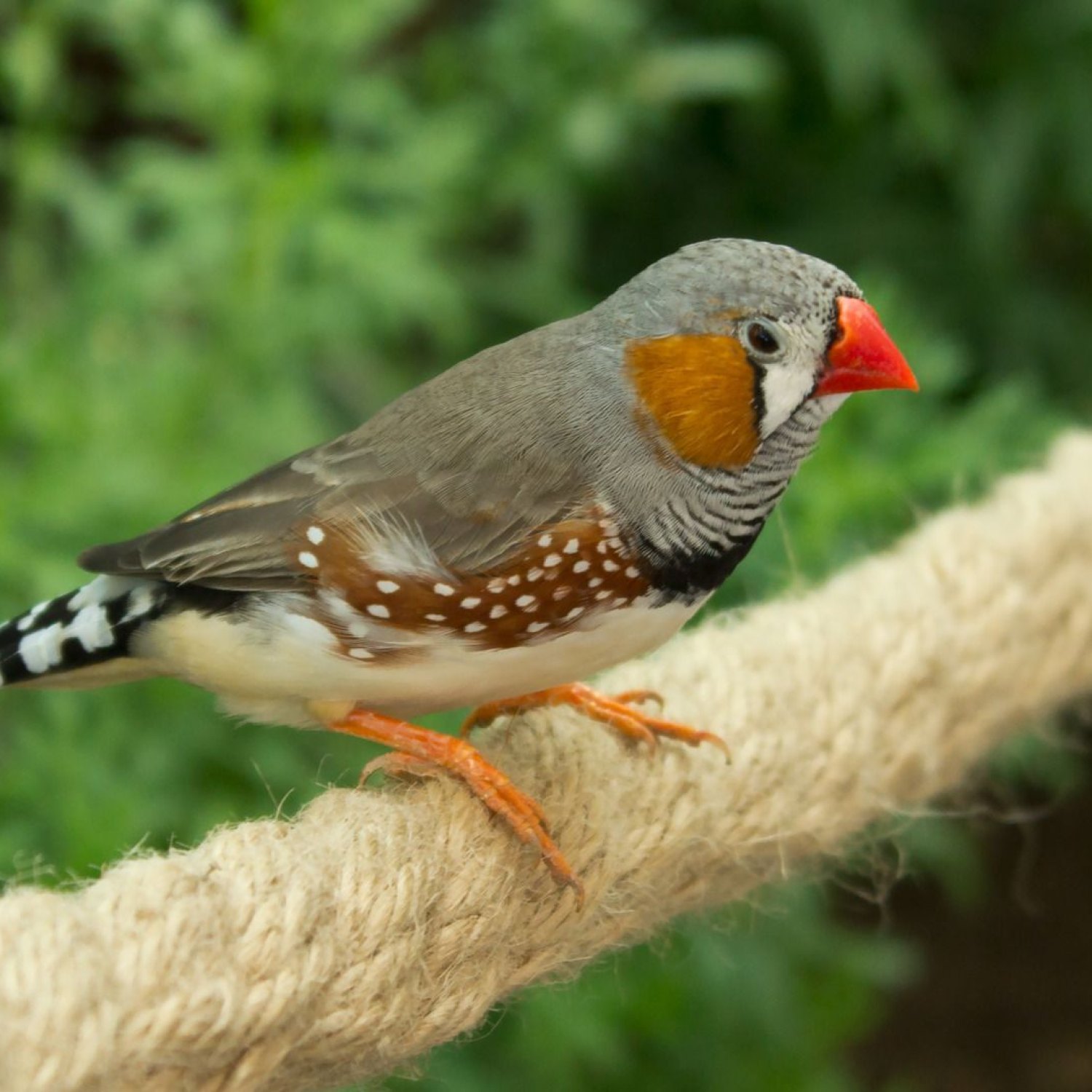
Zebra Finch
9-11 cm (3.5-4.3 in)
The Zebra Finch, also known as the Australian Zebra Finch, is a small but remarkable bird found in the grasslands and open woodlands of Australia. With a length of 9-11 cm (3.5-4.3 in) and a small, compact body, it is easily recognizable by its black and white striped feathers. The pointed beak of this member of the Estrildidae family allows it to efficiently feed on seeds and insects. Keep your eyes open for this beautiful bird on your next trip to Australia! #ZebraFinch #AustralianWildlife
Animal Details Summary:
Common Name: Zebra Finch
Kingdom: Animalia
Habitat: Grasslands and open woodlands
The Colorful and Charming Zebra Finch: An Enigmatic Bird of the Grasslands
The world is full of fascinating creatures, each with their own unique characteristics and features. Among these creatures, birds stand out for their beautiful melodies, vibrant plumage, and diverse behaviors. One bird, in particular, captures the hearts of many bird enthusiasts and nature lovers alike - the Zebra Finch.Scientifically known as Taeniopygia guttata, the Zebra Finch belongs to the vast class of aves, making them part of the kingdom Animalia and phylum Chordata Zebra Finch. They can be found in the family Estrildidae and order Passeriformes, which includes many other small-sized birds. These birds can be found in the grasslands and open woodlands of Australia, Indonesia, and East Timor, making them a cherished native species of Australia.
From their Habitat to Feeding Habits: Understanding the Zebra Finch
The Zebra Finch is a small bird, with a body shape that is petite and compact. They have a distinctly pointed beak, which they use for plucking seeds, insects, and fruits from their surroundings. Being omnivorous, these birds have a diverse diet that allows them to thrive in various habitats, including grasslands and open woodlands. This diet consists mostly of grass seeds and insects, but they are also known to supplement it with fruits and nectar.The Zebra Finches are not picky eaters, and their ability to adapt to different environments has made them a common sight in many areas. These birds are known for their social behavior and are often seen in flocks of up to 100 individuals. However, they also form monogamous pairs during the breeding season, bonding for life with their chosen mate Zokor.
Despite their small size, Zebra Finches are expressive creatures. They communicate through various sounds, including songs, calls, and beak clicking. The males, in particular, are known for their elaborate and complex songs used to attract females and defend their territory. They are highly territorial and will defend their nesting sites fiercely from other birds.
The Aesthetics of Zebra Finches: Beauty in Diversity
One of the most striking features of Zebra Finches is their distinct and unique coloration. As their name suggests, they have a black and white striped pattern, similar to that of a zebra. This pattern is more prominent in males, who also have bright orange cheeks and chest. On the other hand, females have a lighter gray or brown color with faint stripes.Interestingly, the coloration of Zebra Finches also plays a role in mate selection. Females are known to prefer males with bolder and more vibrant patterns, indicating good health and vitality. This preference for colorful mates has led to the popularity of Zebra Finches amongst bird owners as pets.
In addition to their stripes, Zebra Finches also have a small size, which only adds to their adorable appearance. They measure between 9-11 cm (3.5-4.3 in) in length and have a weight of 10-17 g (0.35-0.6 oz) for males and 9-13 g (0.3-0.46 oz) for females. Their small size also makes them agile and swift flyers, allowing them to navigate through their grassland habitats with ease.
The Connection Between Zebra Finches and Their Habitat
As mentioned earlier, Zebra Finches can be found in various habitats, including grasslands and open woodlands. However, their distribution is mainly limited to Australia, where they are found in almost all areas, except for the arid central parts. In this country, they have adapted well to human-altered environments, making them a common sight in parks and gardens.Their preferred habitats consist of open grasslands, scattered trees, and bushes, providing them with ample space to forage while still having cover to hide from predators. They are also found near water sources such as creeks and waterholes, as these are essential for their nesting and breeding activities.
Zebra Finches are known for their resilience and ability to survive in harsh conditions. Their adaptable nature has allowed them to thrive in a variety of habitats, making them one of the most successful bird species in Australia.
The Importance of Protecting Zebra Finches and Their Ecosystem
Like many other bird species, Zebra Finches play a crucial role in the ecosystem. They contribute to seed dispersal and participate in pollination, making them essential to maintain healthy and diverse plant populations. Moreover, they are also prey for various predators, such as snakes and birds of prey, creating a delicate balance in the food chain.However, these birds, along with many other bird species, face threats due to human activities such as habitat destruction, exploitation for the pet trade, and climate change. As a result, conserving their natural habitat and protecting these birds from human interference is critical in ensuring their survival for generations to come.
Fortunately, there are many conservation efforts in place to protect Zebra Finches and their habitats. Organizations such as the BirdLife International actively support conservation projects dedicated to protecting these birds and their ecosystems. Governments and NGOs also work together to establish protected areas and promote sustainable land use to preserve these birds' natural habitats.
In Conclusion: The Charisma and Charm of Zebra Finches
In summary, Zebra Finches are fascinating birds that captivate us with their striking coloration, social behavior, and adaptability. These small but enigmatic creatures have a significant role in their ecosystems and are essential to maintaining the delicate balance of nature.Through this article, we have explored the unique features of Zebra Finches, from their habitat to their diet, and their charming appearance. We have also highlighted the need to protect these birds and their ecosystems for a sustainable future.
So, the next time you come across a flock of Zebra Finches in the grasslands, take a moment to appreciate their beauty and their role in the natural world. And remember, by protecting them, we are not just preserving a species; we are preserving the beauty and diversity of our planet.

Zebra Finch
Animal Details Zebra Finch - Scientific Name: Taeniopygia guttata
- Category: Animals Z
- Scientific Name: Taeniopygia guttata
- Common Name: Zebra Finch
- Kingdom: Animalia
- Phylum: Chordata
- Class: Aves
- Order: Passeriformes
- Family: Estrildidae
- Habitat: Grasslands and open woodlands
- Feeding Method: Omnivorous
- Geographical Distribution: Australia, Indonesia, and East Timor
- Country of Origin: Australia
- Location: Grasslands and open woodlands in Australia
- Animal Coloration: Males: black and white striped pattern with orange cheeks and chest; Females: light gray or brown with faint stripes
- Body Shape: Small and compact with a pointed beak
- Length: 9-11 cm (3.5-4.3 in)
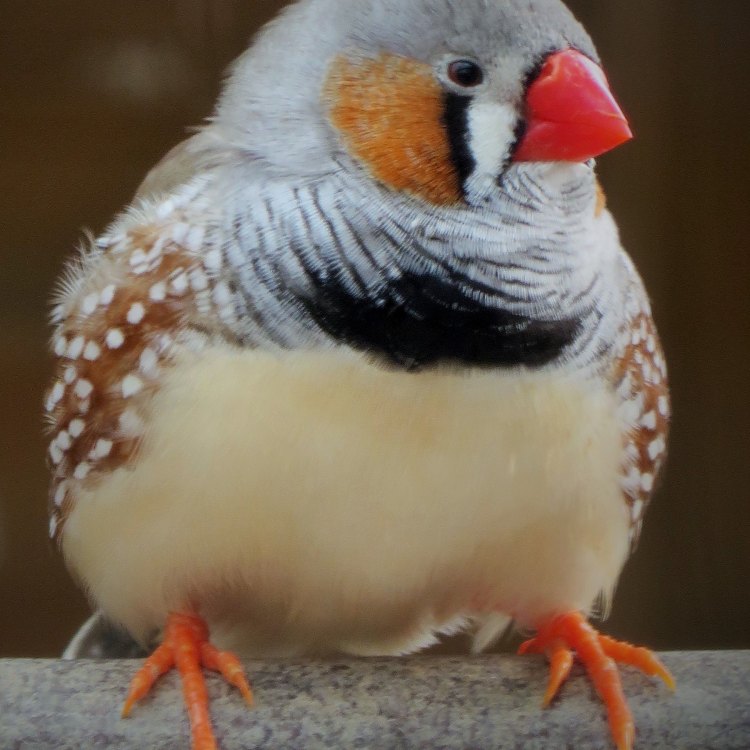
Zebra Finch
- Adult Size: 8-10 cm (3-4 in)
- Average Lifespan: 5-9 years
- Reproduction: Sexual
- Reproductive Behavior: Monogamous
- Sound or Call: Varied and melodic songs
- Migration Pattern: Sedentary
- Social Groups: Flocks
- Behavior: Active and social
- Threats: Habitat loss, predation by introduced species
- Conservation Status: Least Concern
- Impact on Ecosystem: Seed dispersal
- Human Use: Companion pets, research subjects
- Distinctive Features: Distinct black and white striped plumage
- Interesting Facts: Male Zebra Finches learn songs from adult males in their vicinity, and each male has a unique song.
- Predator: Introduced predators such as cats
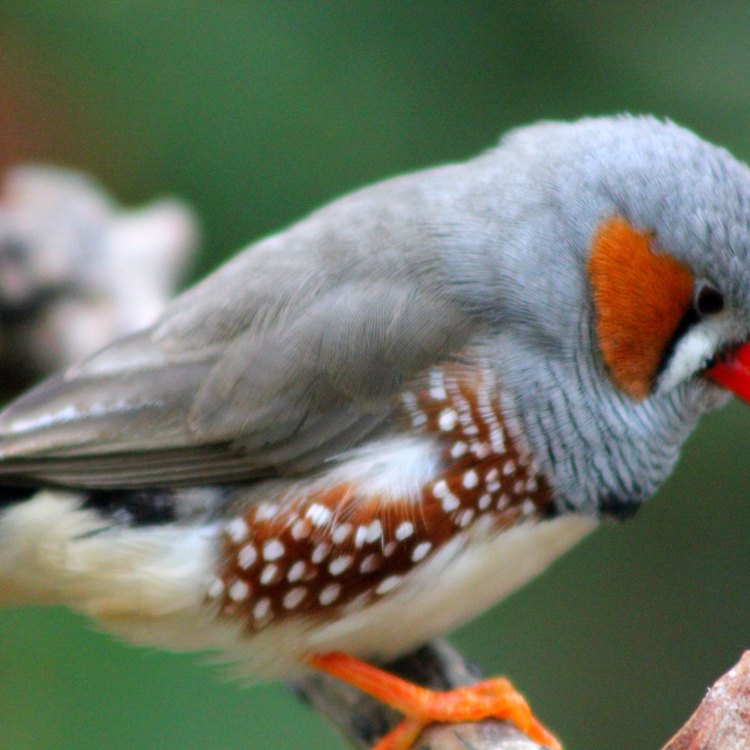
Taeniopygia guttata
The Unique and Fascinating World of the Zebra Finch
When we think of the term "zebra," most of us automatically picture the majestic striped mammal that roams the African savanna. However, have you ever heard of a zebra bird? Meet the zebra finch, a small and colorful bird that is found in the deserts and grassy plains of Australia.Zebra finches, scientifically known as Taeniopygia guttata, are intriguing creatures that have captured the hearts of many bird enthusiasts around the world. In this article, we'll explore the unique features of these birds and their significant role in the ecosystem PeaceOfAnimals.Com.
Physical Characteristics
Zebra finches are small birds, with an average adult size of 8-10 cm (3-4 in). They have a round, plump body with a short tail and a distinctive beak. Unlike their zebra namesake, their plumage is not black and white but rather a combination of gray, brown, and cream with prominent black stripes on their head, neck, and chest.The male zebra finch's most defining feature is its bright orange beak, while the female's beak is more of a pale orange color. However, both of their beaks turn a striking shade of red during breeding season.
Behavior and Social Life
Zebra finches are highly social birds and are usually found in large flocks. They are very active and constantly chirp and hop around, creating a cheerful and lively atmosphere. In the wild, these birds have complex social hierarchies within their flock.One of the most intriguing behaviors of zebra finches is their monogamous nature Zebra Spitting Cobra. Once paired, they stay together for their entire lives, and the loss of a mate is said to cause severe stress and even death in some cases. This behavior is highly beneficial for their reproductive success, as we'll explore later in the article.
Reproduction and Parenting
Like most birds, zebra finches reproduce sexually. The breeding season for these birds is typically during the Australian spring and summer, from September to March. During this time, the male finches put on a vibrant display of courtship to attract their potential mates.After mating, the female zebra finch will lay about 4-7 eggs, which she will incubate for around 12-14 days. Once the chicks have hatched, both parents share the responsibility of caring for and feeding the young until they are ready to leave the nest after three weeks.
Song and Communication
Zebra finches are well-known for their varied and melodic songs, with each male having a unique song. These songs are not only for attracting potential mates but also for communicating with fellow flock members. Interestingly, male zebra finches learn their songs from adult males in their vicinity and can even mimic the songs of other bird species.Aside from songs, zebra finches also use body language and vocalizations to communicate with each other. They have a wide range of calls, including alarm calls to alert their flock of potential threats.
Habitat and Migration Patterns
Unlike many other bird species, zebra finches do not migrate and are considered a sedentary species. They are found in the dry regions of central and southern Australia, including grasslands, savannas, and arid regions. Their ability to survive in these harsh environments is aided by their nomadic nature, where they move from one area to another in search of food and water.Threats and Conservation Status
The zebra finch population is currently not at risk, and they are classified as a species of Least Concern on the IUCN Red List. However, like many other animal species, their future is uncertain, mostly due to human activities.Habitat loss is one of the significant threats to zebra finches, with urbanization, agriculture, and mining causing a decline in suitable nesting and foraging areas. Introduced predators, such as cats and rats, also pose a threat to zebra finches and their nests, as they are not used to dealing with such predators in their native environment.
Impact on the Ecosystem
Although they may seem like small and insignificant creatures, zebra finches play a crucial role in their ecosystem. They are considered seed dispersers, as they feed on various plants and scatter the seeds in their droppings, aiding in plant regeneration and growth. This process contributes to the overall health and biodiversity of their environment.In addition, zebra finches are also a food source for various predators in their ecosystem, creating a balance in the food chain.
Human Use
Aside from their significant role in the ecosystem, zebra finches also have some human uses. They are often kept as companion pets, especially in Australia, where they are readily available and easy to care for. These birds make charming and entertaining pets, with their varied songs and active nature.Moreover, zebra finches are also popular as research subjects, particularly in the fields of genetics and behavior, due to their relatively easy breeding and maintenance in a laboratory setting.
In Conclusion
In conclusion, the zebra finch may not be as well-known as its zebra namesake, but it is undoubtedly a unique and fascinating creature. From their distinctive black and white striped plumage to their social behaviors and melodic songs, these birds have captured the attention of many. However, like many other animal species, their future is uncertain, and it is important for us to take steps to protect and conserve their natural habitats for future generations to enjoy.
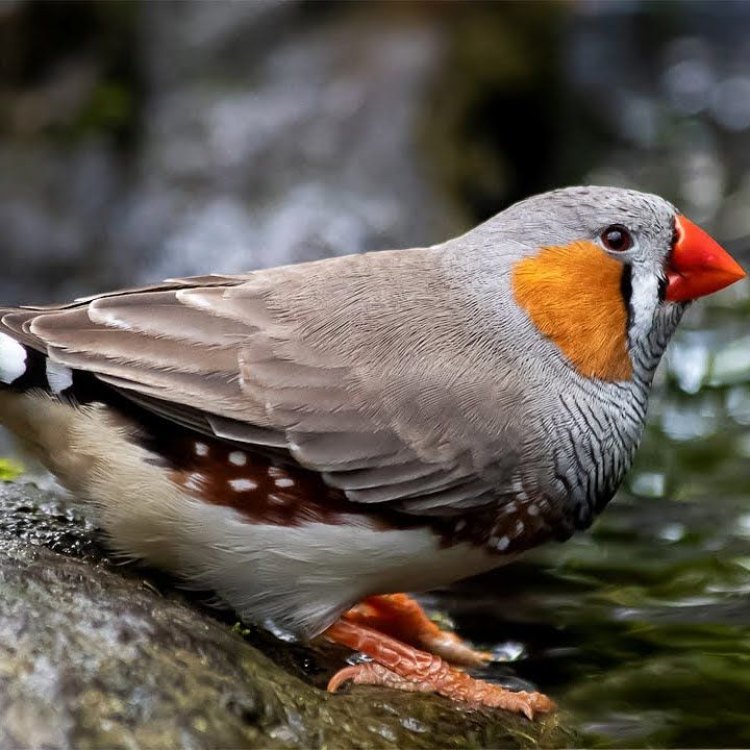
The Colorful and Charming Zebra Finch: An Enigmatic Bird of the Grasslands
Disclaimer: The content provided is for informational purposes only. We cannot guarantee the accuracy of the information on this page 100%. All information provided here may change without prior notice.

